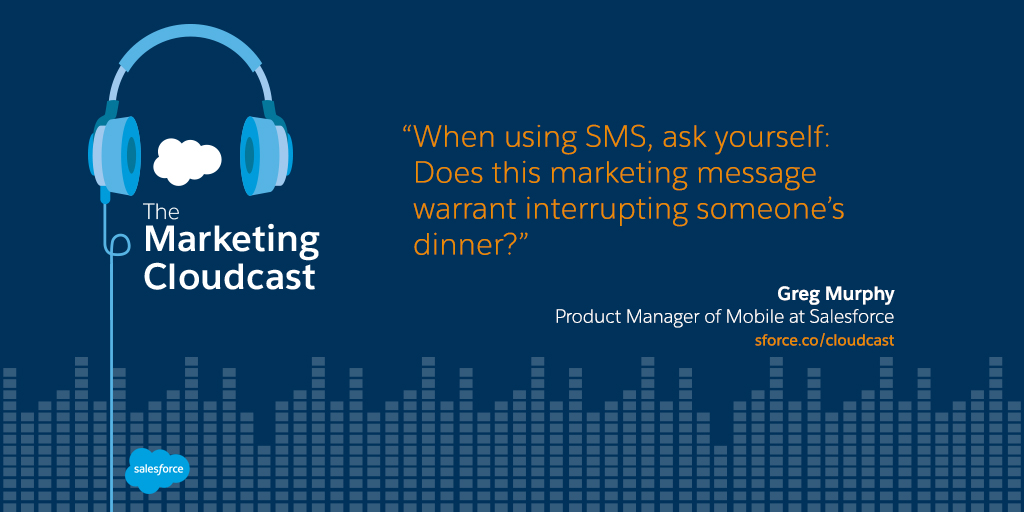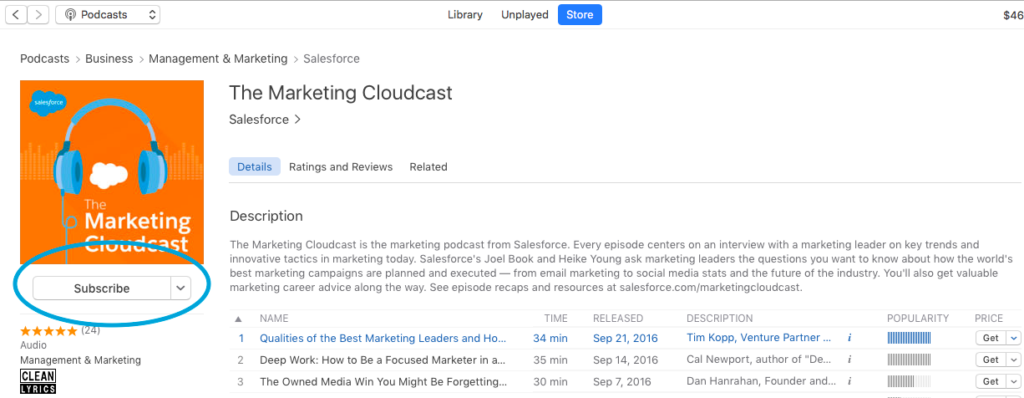Marketers talk about mobile as the future of marketing all the time. We fully acknowledge that customers carry their smartphones with them everywhere; that mobile devices drive more traffic to websites than desktops; and that mobile owns a greater portion of email open rates.
Utilizing an SMS Gateway API can streamline this process, allowing brands to efficiently send bulk messages, track delivery, and engage with customers through an automated, scalable platform.
Yet many mobile marketing channels — for instance, SMS or text-message marketing — are highly underutilized despite the popularity of mobile.
With almost every consumer wielding a supercomputer during their waking hours, what can marketers do to get the most out of mobile technology, especially when it comes to the emerging area of text-message marketing?
On this week’s episode of the Marketing Cloudcast — the marketing podcast from Salesforce — we’re shedding light on SMS marketing and how organizations can incorporate mobile more proactively into the mix. We interviewed Greg Murphy, Salesforce Mobile Product Manager, for the complete low-down.
If you’re not yet a podcast subscriber, check out the Marketing Cloudcast on iTunes, Google Play Music, or Stitcher.
You should subscribe for the full episode, but here are a few takeaways from this podcast episode about SMS marketing.
Table of Contents
1. SMS has an open rate of 98% and a conversion rate of 45%
The numbers don’t lie. “Brands that are actively running programs on the SMS channel are highly aware of that open rate, and that’s driven by the ROI coming back from this channel,” says Greg.
Embedding SMS tactics into your marketing game plan can seriously ramp up engagement with your customers, offering a straight-up and efficient way to get in touch. The cool thing about SMS marketing is its versatility, making it a perfect fit for all sorts of campaigns, from quick-fire promos to custom updates that really speak to what your customers are into.
The trick to nailing this strategy is all about nailing down your audience segmentation, making sure every message hits home and resonates with the right folks. Using a Text expansion tool can streamline the process of creating automated SMS messages at scale, saving time while maintaining a personal touch.
Plus, the big win with SMS marketing is it’s off-the-charts open and read rates, making it a solid bet for getting your message out there fast and keeping up with your audience in today’s non-stop digital world
No email marketing campaign will ever see an open rate near 98%. Similarly, with all the algorithms and factors that affect which social media messages are seen, you can bet that none of your social messages will ever be read by 98% of all your social fans and followers. That makes SMS special.
Let’s face it – we’re all drowning in a sea of emails and app notifications. That’s why a smart bulk SMS service can be your lifeline to actually reaching customers. But here’s the kicker: it’s not about spamming folks with endless promos. The real magic happens when you use texting to make life easier for your customers.
2. 90% of text messages are opened within 3 minutes of being received
Want to send an SMS? Know that 90% of texts are opened within 3 minutes of being received — meaning SMS marketing is “a highly disruptive channel, but a hugely positive disruption for the end user and the brand,” explains Greg.
Retailers especially are seeing impressive ROI from text messages, which result in quick opens and direct responses from consumers in short order.
SMS automation can significantly raise the reach and sales of your business. It is also a very organic way to attract new customers and leads, as well as remind regular customers of your existence. It is very important to approach this process correctly and contact experienced professionals to help maximize communication with SMS for business in order to achieve your goals.
3. Millennials are keen to engage with companies through mobile messaging
Greg says that millennial consumers are highly aware of marketing and being marketed to. He points out, “They know what information they want, and they’d like to gain access to that in an organic way.” This means giving younger customers the opportunity to converse back and forth with your brand on the channel that’s easiest for them: mobile. “That’s what’s best for them because that’s what they’re used to,” Greg shares.
These mobile interactions could take the form of SMS and MMS (text messages including multimedia like pictures) or push notifications and in-app messages. When it comes to mobile, you have a lot of options. Greg says mobile messaging is an “extremely strong channel for bringing users back into your app.” Increasingly, companies are also communicating with customers through Facebook chat, WhatsApp, and other short-form mobile methods, which “is really a testament to how users expect to interact with a brand,” says Greg.
You know what’s crazy about SMS and MMS? These supposedly “old school” text messages are actually beating out all those fancy new apps when it comes to getting people’s attention. I mean, we’re seeing like 98% of texts actually getting opened, which makes email look like a joke in comparison. I’ve been watching brands that get their timing right – you know, not blasting people while they’re trying to eat dinner – and they’re absolutely killing it with their conversion rates.
4. For an awesome SMS program, think useful, not just promotional
“There’s … strong capabilities and proven use cases through the texting channel. Marketers have found success with this channel, but there’s also a huge breadth in capabilities and use cases,” says Greg. To have a truly successful SMS program, think about more than just marketing.
Instead of simply sending promotional texts, Greg encourages users to think out of the box. “Do you want an SMS message when your table is ready at a restaurant? Do you want an SMS when your Uber has arrived? Do you want an SMS when your package has shipped? These one-time messages are very valuable for the brand and the user,” he shares.
In the high-stakes arena of SMS marketing, where every character counts and timing is everything, savvy marketers are wielding a secret weapon: mobile carrier lookup technology. This isn’t just about knowing which network your message is traveling through; it’s about orchestrating a symphony of perfectly timed, carrier-optimized communications.
By harnessing the power of mobile carrier lookup, brands can fine-tune their SMS strategy with surgical precision, ensuring each message rides the optimal wave of connectivity. Imagine crafting carrier-specific campaigns that tap into network promotions, or timing your texts to coincide with peak network performance windows.
This level of granularity transforms your SMS campaigns from a scattergun approach to a laser-focused targeting system, slashing through the digital noise and landing your message directly in the palm of your customer’s hand.
In a world where a millisecond can mean the difference between engagement and obscurity, mobile carrier lookup isn’t just a tool—it’s your backstage pass to the VIP section of your customer’s attention.
5. The disruption of SMS makes it both valuable and a little dangerous.
The simple fact that text messages are so disruptive is what makes them uniquely useful. “They’re going to pull the customer away from what they’re doing and demand attention to your brand. This is what really positions the channel for your brand’s specific mobile moment,” advises Greg.
The trick to getting the mobile moment right? Being selective and communicating minimally. Greg encourages marketers to ask, “Does this marketing message warrant interrupting someone’s dinner?” If the answer is no, it’s probably better to send it through another channel. After all, unsubscribing is simple on SMS, and despite the best personalization tactics, you never truly know the time zone, circumstance, or mood of the person on the other end of a text.
6. The state of marketing today is mobile
Mobile defines marketing today more than anything else. Mobile is where we experience the majority of marketing — and it’s the lens through which we view every marketing message. “Marketers need to keep that at the top of mind,” says Greg.
So how can marketers get creative with mobile? It all starts with that initial moment of need. “Customers have a high expectation that your brand is available to them in that moment of need and that they are going to be able to reach you”.
Marketers need to make these mobile moments happen. “If you’re not doing that, your competitors are,” says Greg.
And that’s just scratching the surface of our conversation with Greg Murphy. You’ll learn much more about implementing a new SMS program, or making tweaks to an existing program, in this episode of the Cloudcast.
Join the thousands of smart marketers who already subscribe on iTunes, Google Play Music, and Stitcher.
New to podcast subscriptions in iTunes? Search for “Marketing Cloudcast” in the iTunes Store and hit Subscribe, as shown below.
Tweet @youngheike with marketing questions or topics you’d like to see covered next on the Marketing Cloudcast.


